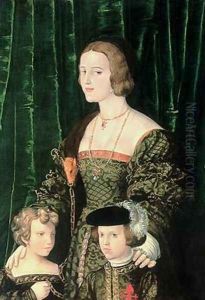(attr.) Landshut, Nicolaus Alexander Mair von Paintings
Nicolaus Alexander Mair von Landshut, born in 1420, was a noteworthy figure in the late Gothic period of art, particularly flourishing in the Southern German region. He was part of the rich tapestry of artists contributing to the late medieval art scene, a period characterized by a detailed and intricate style, bridging the gap between the Middle Ages and the Renaissance. His work, although not widely known today outside of specialist circles, played a significant role in the artistic developments of his time.
Mair von Landshut's artistic output is less documented than that of his contemporaries, but he is believed to have been active in various forms of visual arts, including manuscript illumination, panel painting, and possibly sculpture. The late Gothic style, in which he worked, was marked by an increased attention to naturalistic detail, a heightened expressiveness in figures, and the use of brighter colors, moving away from the more rigid and hierarchical compositions of earlier medieval art. Artists of this period, including Mair von Landshut, were instrumental in laying the groundwork for the Renaissance in Northern Europe, introducing more lifelike representations and a greater depth of emotion and humanity in their subjects.
Despite the lack of extensive records on his life and work, Mair von Landshut’s contributions to the art of his time would have influenced the local art scene, contributing to the rich artistic heritage of Southern Germany. His works, if they were to be identified and attributed to him with certainty, would provide invaluable insights into the transitional period of late Gothic art and the dawn of the Renaissance in Germany. The period in which he lived was one of significant change and cultural exchange, with artists beginning to travel more frequently and ideas spreading more rapidly across Europe.
Mair von Landshut died in 1506, leaving behind a legacy that, while not as celebrated as that of some of his peers, reflects the important shifts in artistic style and technique occurring at the turn of the 15th century. Through his work, he would have contributed to the evolving landscape of European art, bridging the traditional Gothic approaches with the emerging Renaissance ideals of beauty, perspective, and humanism. Despite the scarcity of surviving works definitively attributed to him, Nicolaus Alexander Mair von Landshut remains a figure of interest for historians looking to understand the complexities of this pivotal era in art history.
